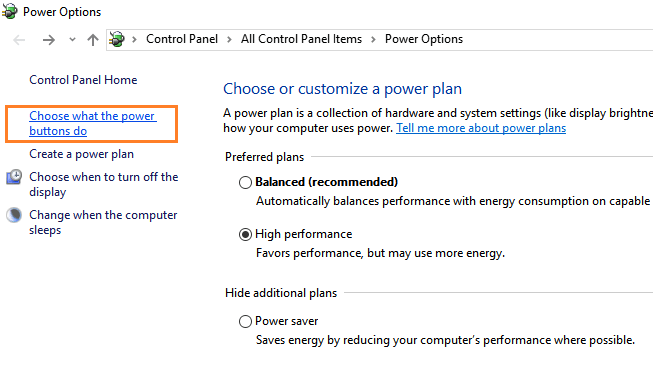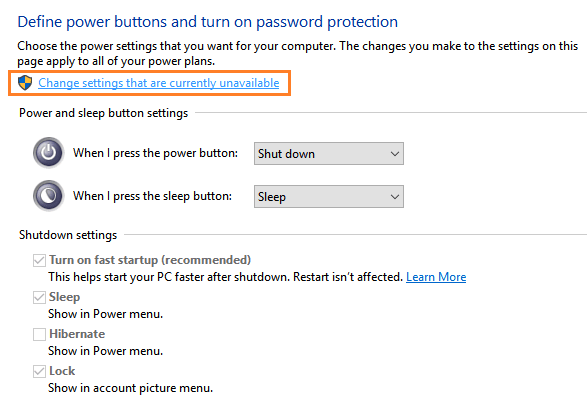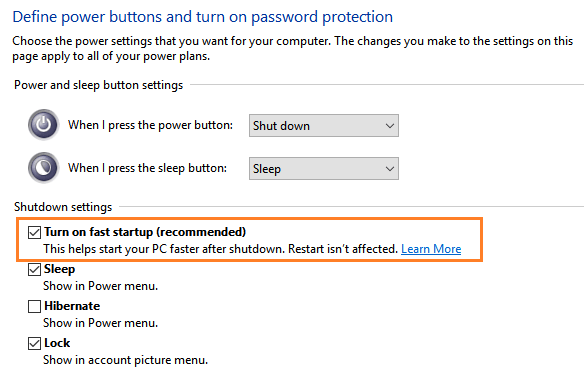Disclaimer: This post may contain affiliate links, meaning we get a small commission if you make a purchase through our links, at no cost to you. For more information, please visit our Disclaimer Page.
Fast Startup, or also known as Fast Boot in Windows 8 or 8.1, works in the same way as the hybrid sleep mode feature in previous versions of Windows.
Technically, it saves the state of your Windows 10 operating system to the hibernation file. The point is to boost the startup process, saving time when powering on your PC.
When you do a fresh Windows 10 installation, the Fast Startup is turned on by default. I can’t deny the advantages of this feature, which helps your computer boot up in a few seconds. However, sometimes it doesn’t work as expected.
In this article, I’m going to share with you the advantages and disadvantages of Fast Startup. This will help you have a clear view regarding this Windows feature. From that, you can make the decision to turn it off or keep it on your Windows 10 PC.
Table of Contents
How Does The Windows 10 Fast Startup Feature Work?
Fast Startup is a combination between the normal shutdown and Hibernate function. Your Windows 10 PC will shut down normally, as usual, close all running apps and log off all users.
Now, the state of Windows is similar to the state when you boot it up but haven’t logged into any user yet. However, all necessary Windows features and drivers are loaded and ready to use. Therefore, Windows will save this state to the hibernation file, and then power off the computer.
[full-related slug1=”5-ways-free-storage-space-windows” slug2=”disable-unnecessary-windows10-features”]When you press the Power button on your computer again, Windows will load the saved state from the hibernation file and show you the login screen. This process is faster because it doesn’t need to load all the essential things again, such as the Windows kernel, or drivers.
Fast Startup is somewhat similar to the Hibernate function and can be considered as a lightweight version of it. Fast Startup saves the freshly-started state of Windows. Meanwhile, Hibernate saves everything, including the current state, logged in users, or open files, folders & applications. If you want to get back the exact state when you left your work, Hibernate is a great option but takes longer to boot up.
Two Main Reasons Why You Should Disable Windows 10 Fast Startup
You might consider this is a great option in Windows 10, and it should be enabled all the time. However, there are a few downsides and issues that you might want to know. Here are two main reasons you should know before turning on the Fast Startup feature:
- Your computer doesn’t shut down legally: Technically, your Windows 10 PC won’t be shut down when Fast Startup is enabled. It just gets in a kind of hibernate mode. Therefore, your computer won’t be able to install & apply Windows updates. If you are in this situation, you can reboot your computer and install updates regularly as the Restart function is unaffected. Besides, you may not be able to access BIOS/UEFI settings because your computer doesn’t perform a full shutdown mode. To access BIOS/UEFI settings, you can also perform a reboot instead of shutdown when Fast Startup is enabled.
- Unable to access files on your primary partition: When enabling the Fast Startup feature and then turning off your computer, the main hard drive (C:\) will be locked. Therefore, you won’t be able to access it to get files & documents. This is a clear disadvantage for users who need to use Dual Boot on the same computer. You may also cause some corruption when trying to boot into another operating system and access this drive to get files. Therefore, if you want to use Dual Boot, then definitely you shouldn’t enable Fast Startup or Hibernation.
Besides, sometimes the Fast Startup feature doesn’t work properly and causes some BSODs, such as Bad Pool Header. Therefore, I would recommend disabling it to avoid any problems you may encounter in the future.
How To Enable Or Disable Windows 10 Fast Startup
In case you have made the decision to turn on or off the Windows 10 Fast Startup, here are the steps you have to follow to enable or disable it:
Firstly, press Windows + X, and then select Power Options from the pop-up menu.
Look at the left sidebar and click on the “Choose what the power buttons do” option.
In the next step, click on the “Change settings that are currently unavailable” option.
The “Turn on fast startup (recommended)” option will be there, along with all the other shutdown configurations. All you need to do is to check or uncheck the box to enable or disable Fast Startup, respectively.
If there are only two options: Sleep and Lock, then it means Windows Hibernate isn’t enabled yet. In this case, you have to turn it on before you’re able to enable Fast Startup.
To do so, press Windows + X, then press A and select Yes to launch the Command Prompt with administrative privilege.
In the Command Prompt application, execute the following command to enable Windows Hibernate:
powercfg /hibernate on
After that, both the Hibernate & Fast Startup options will appear on the configuration page, as I mentioned above.





